After the Elk Valley Ultra was completed, inside my personal time goal, and therefore could be considered a success, I could not wait to do it again, and prove to myself that it wasn’t a fluke, that I really was an “ultrarunner”. One could argue that doing a little over 50K doesn’t look all that “ultra” given that a regular marathon is 42K, but generally those don’t climb over 9,000 feet in the process. So it felt pretty ultra to me.
I had my eye on a loop in Banff National Park, which appeared to be a little over 60K at first glance, but studying a paper map instead of the tiny screen of an iPhone app, it came out closer to 75K. Perhaps a little too ambitious. I decided on the Rockwall Trail in Kootenay National Park, a 55+K trail that crosses over 3 or 4 mountain passes, rivaling in elevation gain the Elk Valley Ultra.
Four weeks after the Elk Valley experience we drove into BC with two cars. Rockwall trail is not a loop, you end up about 13km from where you started, so you either hitch hike, or arrange a drop. My daughter was shanghaied into coming out early. She would do a part of the trail, taking the dogs, and drive home when done.
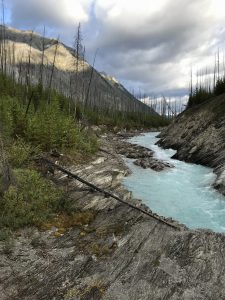 We started at the Floe Lake trailhead around 8:20AM. Right off the parking lot we dropped down to a bridge across the Kootenay River. A small group of runners was getting ready, but we were gone before they got organized. After crossing, I said goodbye to my daughter and the mutts and started a slow jog up a meandering trail that ran through a giant burn. Walking the steeper bits, jogging where I could, I made decent time, passing a few hikers, meeting some backpackers on their way out, and hearing for the first time about a group of runners ahead of me.
We started at the Floe Lake trailhead around 8:20AM. Right off the parking lot we dropped down to a bridge across the Kootenay River. A small group of runners was getting ready, but we were gone before they got organized. After crossing, I said goodbye to my daughter and the mutts and started a slow jog up a meandering trail that ran through a giant burn. Walking the steeper bits, jogging where I could, I made decent time, passing a few hikers, meeting some backpackers on their way out, and hearing for the first time about a group of runners ahead of me.
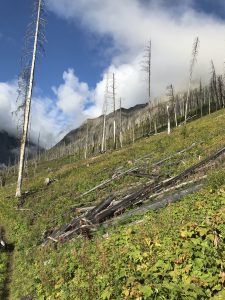 The last few kilometers up to Floe Lake were steep! No running here for me, just grind uphill. Weather was good, legs still felt OK, scenery was great. Floe Lake was rather bleak-looking, bordered by towering grey rock, jutting into a now overcast sky, a stark contrast from the lush, green, sun-filled valley below.
The last few kilometers up to Floe Lake were steep! No running here for me, just grind uphill. Weather was good, legs still felt OK, scenery was great. Floe Lake was rather bleak-looking, bordered by towering grey rock, jutting into a now overcast sky, a stark contrast from the lush, green, sun-filled valley below.
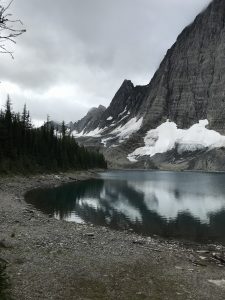
From Floe Lake it is less than 3K to the first pass of the day: Numa Pass. A short section of alpine meadows takes you to the scree-filled pass, after which you drop down quickly back into the trees. It had taken me about 2 hours and 40 minutes to reach Numa Pass; hard to imagine that there was still a marathon left to do.
After bottoming out, the next climb loomed: 5K up to Tumbling Pass. A large part of this trail run through willows and alder bush, at least 10 feet tall, restricting any kind of view other than a few glimpses. It’s just grind-grind-grind, until the terrain finally opens up, and you reach the pass, which is a little friendlier than Numa, with stunted trees and grassy patches. Good spot for lunch, if you are the lunch-having kind. Roughly 26K done, and 5 hours in, there still was about 30K to go. The view of the trail ahead was part exhilarating and part daunting.
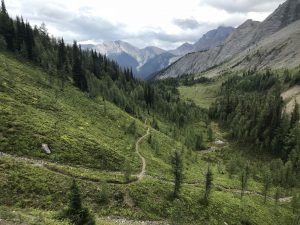
The descent to Tumbling Creek took me through a larch forest, from which there were glimpses of the next obstacle: Rockwall Pass. Just before the Tumbling Creek campground I chatted briefly with a guy who was curious if we were “all” training for an upcoming race, and he mentioned the other group of runners, still ahead of me.
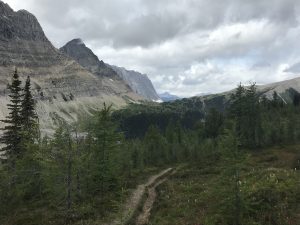
A much shorter climb brought on the Rockwall Pass area. Hugely open, alpine meadows, marmots, views, wide trail, a fellow could feel mighty good about himself having made it up here, and I did.
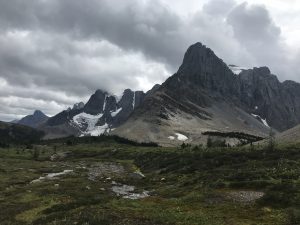
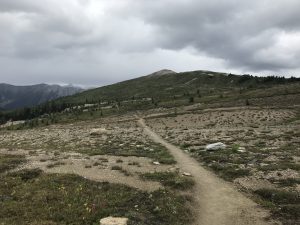
Rockwall Pass was glorious. After the high point the trail dropped down to a small lake, and a great view of the rock that gave the pass its name. About 35K in, 7 hours after leaving the trailhead, it started to drizzle. A short climb through flowery meadows took me up to the last view point of any significance of the day. Looking back to the Rockwall area certainly was a sight to remember.
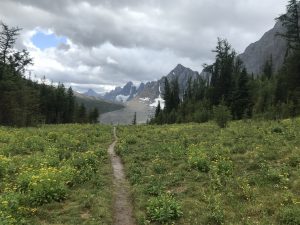
After a brief chat with two backpackers, I started the long descent to the Paint Pots trailhead, where I had left the truck. The steady rain quickly turned the trail into mud, the larch forest that I crossed looked gloomy. Hard to fathom there were still over 18K to go. I was starting to feel worn out, and my feet were hurting. Where four weeks ago I found a second wind, there was no wind to be found in the body this time.
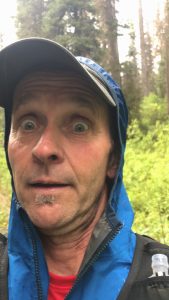
The next seven or eight kilometers I went too fast for the way I was feeling. I glanced at Helmet Falls, but couldn’t find the strength to take a side trip for a closer look. Somewhere past the campground I caught a glimpse of something moving up ahead on the trail, and with still about 10K to go I came up behind a young couple, who had started before me. They asked for a ride back to the Floe Lake trailhead, should we arrive at Paint Pots together.
For the next two hours we kept exchanging the lead. I tried to create some distance, but I was pretty much spent. With the rain now relentless, it became a mud slug, alternating between walking and running, with hardly a view to lift the spirit. The green, gloomy tunnel went on forever it seemed, but just as it all seemed to become a little too much, the ground turned a dark orange. I made it to the Paint Pots, and so had my on-and-off running partners.
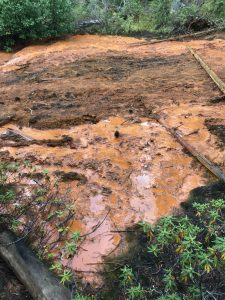
The Coros watch app reminds me I took 10 hours, 42 minutes and 19 seconds to cover the 55.4K, climbing some 8,700 feet in the process. The other guys took 12 hours. Like for me, it was only their second time covering a distance longer than 50K. They were very happy with the ride back to their vehicle, I was happy to be able to help them. I always thought heated seats were for sissies, but I think I kept the heat cranked high all the way home, to sooth the aching muscles.
If I were to do this trail again, I’d start at Paint Pots, and get the less-inspiring bit in the trees done first.
FD